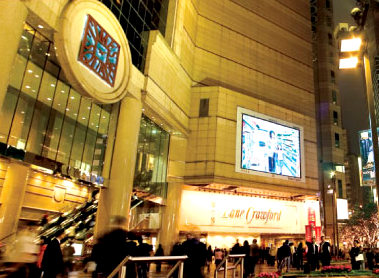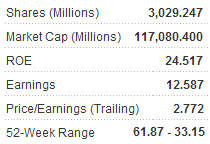
Translated by Andrew Vanburen from: 靈活風險低以紙磚頭代樓 (中文翻譯, 請閱讀下面)
THE SEEMINGLY endless stretch of depressed valuations, high inflation and low interest rates continues with no end in sight, leaving few viable options for investors on where to put their hard-earned money.
For those of us looking for a stable bet with gradual, near-guaranteed returns, I would recommend the brick and mortar sector, i.e. real estate.
Pure rental counters are admittedly hard to find, so one has to look more closely into market potential.
Wharf Holdings Ltd’s (HK: 4) mega-retail venue Harbour City in Kowloon and shopping center/office tower complex Times Square in Causeway Bay are two such assets, but both have not been alone in operating under the shadow of the global economic downturn and the bearish sentiment in Hong Kong, with rental incomes having slipped by 20-30% in some cases.
Therefore, perhaps real estate investment trusts (REITs) are a better bet these days.
Yes, these investment vehicles that bundle a sometimes motley assortment of real estate assets and mortgages into an investible entity were until quite recently considered a dirty word on bourses worldwide.
As REITs are more arcane than a direct, straight-up listed developer, they can sometimes be misunderstood and manipulated, with some pointing to their prominence in 2008 as one of the major tipping points for the global economic meltdown, taking major financial institutions like Lehman Brothers with them.

At the very least, they are likely to provide stable investment income if they are more heavily weighted with pure rental assets, so I would recommend only those REITs with at least 90% exposure to this revenue stream should be seriously considered during these tough times.
But just as a few years ago when gold was being touted, non-believers outnumbered believers, and look who’s laughing now.
I believe that recently, rent-based REITS -- like gold investing -- never promise to double returns overnight, and it is a strategy more suited to the patient, long-term investor with a low tolerance for risk.
Progress is intolerably slow for some investors, and that is understandable.
However, I believe that too often for the conservative retail investor, overemphasis is put on the number of edifices, shops and parking spaces, and too little attention is paid to footfall traffic, location and consumption trends down the road.
In other words, successful investors in real estate – and REITs in particular – have a habit of assessing more than the brick and mortar assets of a particular investment and look also to growth trends two, three or even five years into the future.
Perhaps readers would be better served to reference Skills of a Winning Investor (投資必殺技) which more thoroughly explicates the theoretical value versus intrinsic value debate.
Property purchases invite high rental income risk
We’ll call the unlucky heroine of our instructive story “Yizi.”

Out of a sense of familial obligation, she rather blindly accepted her younger brother’s request to put the young man’s property investment in her name.
Rather than buying a few residential units here and there based on affordability and location, the younger brother had convinced his big sister that by buying an entire apartment building, they could maximize their returns and win back their investment in a matter of months, not years.
Yizi reluctantly agreed to her sibling’s reasoning and put the entire edifice in her name.
Soonafter, the financial meltdown appeared on the horizon, tenants began moving to cheaper digs, those who decided to stay renegotiated for lower rent terms – citing the economic downturn – and the apartment building soon had many darkened windows at night and became a loss-making investment for Yizi and her brother.
However, REITs allow a broader exposure to different regional markets and income scales which means that the lower-end units will generally have less vacancy issues during sporadic downturns.
In Hong Kong, Yizi’s case study is a seldom seen story, fortunately, because few possess the capital or cheap loans to afford buying entire residential complexes.
I believe this makes for an even more compelling case vis-à-vis the benefits of REIT investing these days in the Hong Kong market.
See also:
HK Tycoon's Chow Tai Fook Jewellery IPO May Top 30x P/E
HONG KONG: ‘Zero Tolerance’ For Listco Irregularities
靈活風險低以紙磚頭代樓
(文: 黃國英, 豐盛融資資產管理部董事)
股票積弱難返,通脹仍在,低息環境持續。
對不欲頻頻出入者,多建議買磚頭了事。純粹收租股,難以尋找,九倉(0004海港城、時代廣場護身,但因背負內房陰影,跌兩、三成也是等閒。房地產信託基金(REITs)實是較佳選擇,坐樓收租,可分派收入起碼派九成。但一如很久前推介黃金,都是不信多於相信,信者亦多只觀望,齋睇唔買。進取者嫌慢,可以理解;但不少保守型散戶,卻只相信真磚頭:樓、舖、車位,而不信紙磚頭。打算稍解此一迷思,碰巧讀了一套名為「投資必殺技」的漫畫,恰好提供了不錯的思考架構。
買樓收租風險高

故事女主角依子,替弟弟作擔保,詎料衰仔走數,惟有自力還錢。萬念俱灰之際,遇上房產達人,謂可教其投資之術,賺錢填數。最初依子以為,求其買個單位便可,達人卻當頭棒喝,話一係唔買,一買就買一棟。因為如全棟樓空置率2%,只是收少2%租,仍可以慢慢捱;得一個單位收租,一無客便是零收入。後達人再帶依子訪尋整棟銀主盤,不在話下。
在香港,有能力買起全棟樓,人數或有限。但概念套在REITs上,亦合情理。買入單位,有無人租、肯唔肯交,頗為講運,還未計新舊約交接的空檔。反而REITs揸住一堆商舖、寫字樓,就由運氣演化成統計數字,好景時空置幾%,轉差時多一、兩成,有數得計,而不是或有或無的二分法。還有水火二災、變成凶宅的風險,也得以移除。
另一幕,依子接到傳單,有樓出售,號稱回報九厘。以為是良機,達人卻一手撕碎。因為這只是「表面回報」,扣去稅收、管理、維修等費用,肯定是水瓜打狗。回報不過爾爾,卻着力派通街,應有蠱惑。現時本地房產,表面回報也是三、四釐,似乎與領匯(0823等相去不遠。問題是REITs的派息,已將成本、稅負扣乾扣淨,即時落袋,買樓收的租,則距實際回報,還有漫漫長路。
或曰:買樓可用槓桿,放大樓價升值。先不討論樓價會否大升,要用孖展操作REITs,只要不過大,導致跌少少便被斬,並無不可。而且REITs本身也會借貸,也有槓桿效應。計入樓宇出入使費、新增的特別印花稅,及走位的靈活性,實樓未必勝過REITs極多。須知市況不濟,仍可大注劈領匯搵食,賺一塊算一塊,使費有限,也沒有資本增值稅。
政府產品可信賴
當然,散戶不信REITs,有其現實原因。板塊在本地出現,不足十載,不如傳統藍籌,沒人有長揸賺錢經驗,中財技倒地險情,反而時有所聞。但這些年來,財技已漸到盡頭,可選的仍有一、二。Rule of thumb是逢新勿入,不信邪者請參考人仔REIT。懶做功課,單騎領匯也不算冒險,政府在財經領域的產物,往績不差,港鐵(0066)、iBond(4208)可為佐證。
既然買紙黃金,可以代替實金,破除心魔後,以紙磚頭代樓,亦沒甚大不了。
請閱讀:
CHOW SANG SANG, FOCUS MEDIA: Jewelry, Ads Show Recession-Resistant Results







